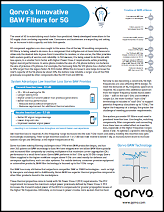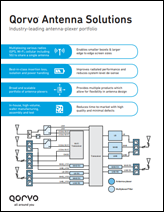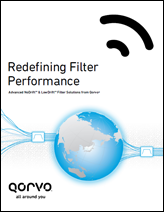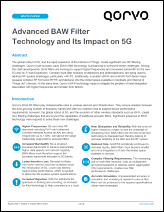Mobile Filters
Greedy antennas? Teach them to share with our filtering solutions.
5G brings no shortage of challenges for smartphone designers. New bands drive wider bandwidths, higher frequencies and the need for even more efficient front-end antenna design – with more antennas that ever before. Our filters address the complex carrier aggregation (CA) requirements of today to simplify the antenna architectures of tomorrow.
As band counts rise and best-in-class filter performance is required, we leverage our leading advanced filtering technologies to create discrete filters, multiplexers and antennaplexers to tackle the mobile industry’s toughest interference problems.
Mobile Filters Brochures
Qorvo's Filter Products for Mobile

Our filter technologies achieve breakthrough performance by dramatically reducing temperature sensitivity, resulting in improved insertion loss, longer battery life, fewer service disruptions and dropped calls, and an enhanced user experience.
Discrete Filters/Duplexers – Premium filter products offer compliance to the toughest spectrum challenges and meet antenna Power Class 2 requirements.
Antennaplexers – Enables complex antenna sharing by providing low loss path and superior out of band rejection..
Multiplexers – Combining Tx and Rx filters into compact modules with best-in-class performance that simplify the complexities of CA in 5G architectures.
The Evolution of 5G CA
Carrier aggregation (CA), 4x4 DL MIMO, HPUE, CBRS and LAA are growing across the world.
Carrier aggregation (CA), 4x4 DL MIMO, HPUE, CBRS and LAA are growing across the world. The number of 4G LTE frequency bands is increasing. We are also moving into an era of downlink CA beyond 5 Component Carriers (CC). High Performance UE (+26 dBm) usage is expanding as is LAA (Licensed Assisted Access) in unlicensed 5 GHz spectrum enabling small cell densification.
The U.S. is about to embark on 3.5 GHz in shared spectrum, Citizens Broadband Radio Service (B48 CBRS), which will enable expansion of private LTE networks and neutral hosts. 2018 will bring the rollout of the FirstNet B14 LTE system for first responders, which will be available for usage in consumer cell phones where spare capacity exists.
3GPP has approved the first 5G New Radio (NR) Specification (38.101) using an LTE anchor in a Dual Connect configuration of LTE and 5G systems, called non-standalone (NSA NR). 5G will initially use FR1 (Frequency Range 1, <6 GHz) bands n28, n41, n71, n77, n78 and n79; then mmWave FR2 (Frequency Range 2, >6 GHz) band n257 (28 GHz); and followed by n260 (39 GHz).
| Region | Deployed | Planned |
|---|---|---|
| Europe | 3CC_CA, UL 2CC_CA B1, B3, B7, B20, B28, B38 |
4CC_CA, LAA, L+L CA B40, B46, n28, n78 |
| China | 3CC_CA, UL 2CC_CA B1, B3, B5, B8, B39, B40, B41 |
UL 3CC_CA, 4x4 MIMO, HPUE B38, n78, n79 |
| South Korea | 5CC_CA, UL 2CC_CA, 4x4 MIMO B1, B3, B5, B7, B8 |
LAA B46, n78, n257 |
| Japan | 4CC_CA, 4x4 MIMO B1, B3, B11, B18, B19, B21, B26, B28, B41, B42 |
5CC_CA, UL 2CC_CA, HPUE n77, n79, n257 |
| Australia | B1, B3, B5, B8, B40, B41 | 2CC_CA |
| U.S. | 4CC_CA, 4x4 MIMO, LAA, HPUE B4/66, B5, B12, B13, B2, B30, B41, B46, B71 |
>5CC_CA, UL 2CC_CA, CBRS B14, B48, n71, n41, n257, n260 |





